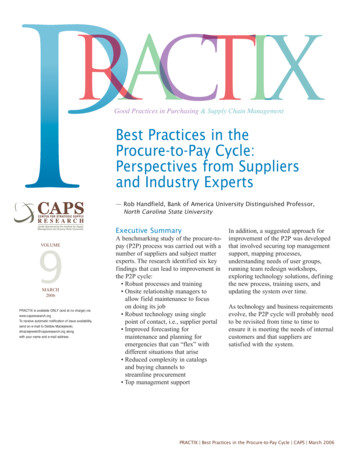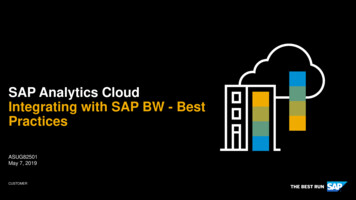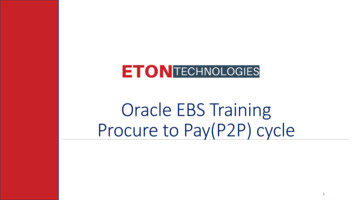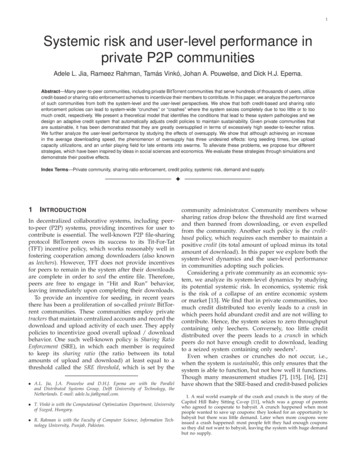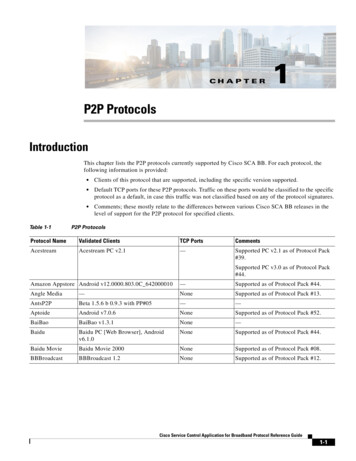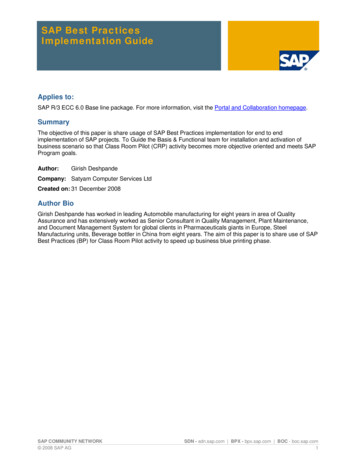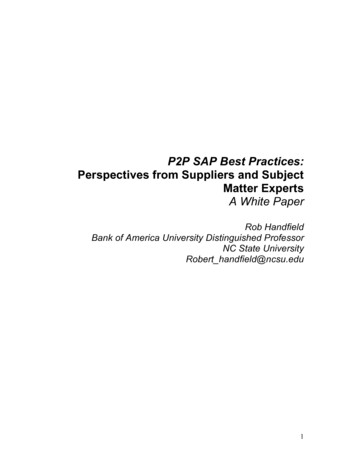
Transcription
P2P SAP Best Practices:Perspectives from Suppliers and SubjectMatter ExpertsA White PaperRob HandfieldBank of America University Distinguished ProfessorNC State UniversityRobert handfield@ncsu.edu1
EXECUTIVE SUMMARYA qualitative study of the Procure to Pay (P2P) process was undertaken by theresearch team in order to determine the symptoms, root causes, andrecommended approaches to identifying and solving the problems associatedwith the P2P process in the SAP environment. We interviewed a number ofsuppliers who shared their insights in working with companies in an SAPenvironment, and interviewed a number of subject matter experts. The researchidentified six key findings that can lead to improvement in the P2P cycle: Develop common processes and procedures for the P2P process, androll-out training at site level to ensure that people are comfortable with theapproach. Be prepared to modify minor elements the process toaccommodate site-level requirements, but keep the essential elements ofthe process flow intact. Emphasize the importance of this approach to theentire P2P cycle, including accounts payable, invoicing, and blocked andparked invoices. Explain the impact of lack of adherence to process – andthat the supplier will not be paid in a timely manner for their work if errorsoccur in the process.Improve master data robustness and integrity. Whether this involvesensuring proper audits of external vendor catalogs, or internal contentmanagement, clean master data is a mundane but critical element tosupply management and P2P best practices. Minimize opportunities inthe P2P process for keystroke and freetext errors to occur, by errorproofing the system and mapping the process to identify where errors areoccurring. Recurring training will also ensure that errors are reduced.Explore punch-out roundtrip and other approaches to exploit externalcontent management approaches. This is especially important to ensurethat the most efficient buying channel is selected.Exploit the use of procurement cards for high transaction volume, lowtransaction value purchases. Pcard technology has evolved significantly,and companies need to identify opportunities for hard dollar savingsthrough this approach via rebates.Be sure to update master data and pricing rates on an on-going basis. Inparticular, attention should be paid to units of measure, appropriateindustry-standard nomenclature, updating of labor rates based on marketconditions, and on-going clarification of requirements against existingcontracts.Establish how you are buying products and services, and document thebuying channels through which these purchases are occurring. Inevitably,you will discover that purchases are occurring through improper or lessefficient channels, which is detracting from your team’s ability to engage instrategic value-added approaches.Get out of the transactionmanagement business! To do this, you need to establish standardprocesses and procedures, and commit to a change management plant to2
ensure that people are using the right buying channels for the differenttypes of spend.As technology and business requirements evolve, the P2P cycle will certanlyneed to be re-visited from time to time to ensure it is meeting the needs ofinternal customers, and that suppliers are satisfied with the system.3
Procure to Pay Best Practices: Perspectives from Suppliers andIndustry ExpertsIntroductionAs more companies are seeking to move beyond procurement into fully deployedsupply chain systems, a key challenge for many companies is in the area ofimproving efficiency in their procure to pay cycle for many of their contractedservices, especially in the area of facilities maintenance and on-site contractmanagement. There exist multiple challenges in environments where fieldassociates are working from manual or electronic systems, requisitioning on-siteservices for maintenance or other activities, and ensuring that this information iscaptured effectively. In addition, there exist significant challenges to ensure thatthe proper service level agreement is fulfilled, the correct price is charged, thepurchase order is transmitted correctly, the invoice matches, and finally, that thesupplier is paid the correct amount for the actual services delivered. While manyenterprise systems claim that these elements are simply defined within theirstructural logic, the truth is that there are many opportunities for error, and thatwithout a planned process for managing the procure to pay cycle, yourorganization may be bearing significant costs due to non-compliance to systemor process requirements.A qualitative study of the Procure to Pay process was undertaken by theresearch team in order to determine the symptoms, root causes, andrecommended approaches to identifying and solving the problems associatedwith the P2P process. Moreover, the team was interested in seeking answers tothe following questions:What the symptoms of the problem that are being experienced by internalbuyers, vendors, and subject matter experts?What do these groups of respondents believe are the underlying root causefor these problems?What are the recommended solutions and potential benefits associatedwith the solutions suggested by respondents?This benchmarking study sought to define and understand the best practicescurrently being employed by companies in the procure to pay cycle for services.Specifically, the research team focused in learning and sharing best practices inthe following areas shown in Figure 1: Forecasting and Planning of RequirementsNeed Clarification / SpecificationSourcing Decisions in Emergency / Non-emergency situations4
Contract P/O Generation for Structured or Unstructured requirementsReceiving of Services, Materials, and DocumentsSettlement and Payment in Accounts Payable.Procure to PayGeneric High Level Process MapStartForecastPlan ingDecisionContract / POGenerationReceiveMaterial& DocumentsSettle andPaySupplierNeedFulfillmentFigure 1Research ApproachIn order to explore how an organization should approach improvements to theP2P cycle, we adopted a grounded case-based research approach to identify theissues and develop a framework for analysis. Case research requires that a setof detailed interviews with a small sample of firms involved in the phenomenon ofinterest be studied in detail to determine qualitative insights into the linkages.1Before beginning a case study, however, it is necessary to have a conceptualmodel for crafting research instruments and protocol.2 The conceptual model forstudying the research questions was therefore derived, based on existingliterature as well as a kick-off meeting held in early June.1K. Eisenhardt, “Building Theories from Case Studies,” Academy of Management Review, 14, p. 532-550, 1989.M. Miles, and A. Huberman, Qualitative Data Analysis (Second Edition). Thousand Oaks, CA: SagePublications, 1994.25
Next, an interview protocol was developed based on a general understanding ofissues facing the organization and the hypotheses developed. (See Figure 1.)Questions focused around the workflow associated with the movement andmanagement of materials and services to the company’s facilities, and includedvendors and subject matter experts from a number of external companies. Keyrespondents were identified in each of these areas, and interviews were carriedout using the structured interview protocol.We first interviews nine suppliers who had worked closely with SAP customers.Next, we identified a group of subject matter experts in the form of senior supplychain management executives who described a number of “best practices” theyhad deployed within their respective organizations to specific problems identifiedby the suppliers within the P2P cycle. Each of these individuals had workedspecifically in the area of the P2P cycle, and had gone through steps to addressthe issues through specific improvement projects. Both groups were interviewedand provided feedback and observations.Following each interview, the field notes were written up in typeface. The nextstep (which occurred after to the site visits) involved coding this data Thetranscribed field notes were reviewed several times by the research team, inorder to code the events into their appropriate categories, (consistent with theconceptual model), and to compare field notes taken during the same interview.In the remainder of the report, we describe the results used for assessing thefirms, then describe the classification of responses from the interviews. Finally,we conclude with the implications of for organizations seeking to rapidly improvetheir procure to pay cycle.A Supplier’s View of the P2P ProcessWe first began by identifying the true customer of the P2P process: the supplierwho wishes their invoice to be paid quickly! Many organizations are seeking tobuild and extent relational capital with suppliers, by building trust and becomingthe “Customer of Choice”. The capital gained through this approach can result inpreferred supplier delivery priorities, information sharing, participation on suppliercouncils, and other important rewards. An important element in becoming a“Customer of Choice” is to enable rapid payment, equitable and ethical treatmentof suppliers.To address some of the major problems identified by suppliers, we scheduled aseries of interviews with a group of suppliers from a large company, to identifytheir experiences with the current procure to pay process. These interviews werecoded and summarized to identify a set of seven key symptoms that are mosttypically associated with suppliers’ experiences with an ERP-generated procureto pay process.6
The good news from suppliers was that the company appears to be running verywell with payables. Suppliers noted that: They are generally running within terms.Few problems with receivables or parked/blocked PO’s.No major complaints on payables.The AP workflow is fantastic – and they are great on getting thingsfixed. If there is a blocked invoice, they put it back in right away.However, this may not necessarily be the best policy to manage the cash to cashcycle. Currently, invoices are being paid almost immediately upon receipt, withrelatively few blocked or parked invoices.UPDATING CONTRACTED LABOR RATES ARE DELAYEDOne of the first problems noted is that labor rates were often not updated on aregular basis. In some cases, problems are not discovered for an extendedperiod with a contract. Another major problem is that with escalating labor ratesin this market, contracted rates are often not aligned with market labor prices. Asone supplier noted: The way our process works – our contract is reliant on wages. Weare in a very competitive market right now – our competition is hiringour workforce as fast as we are hiring theirs – and our hourly payrates are going up. We have to stay in the market. We have a a newrate schedule for Jan 1 where we have had to bump 40% of the ratesby 5-10 – probably in the range of 10-15%. But that is the market!We saw this year a 15% wage increase, and we are not through. Theissue is that we need when executing the work if we need to movesomeone from one project to another – they have to fit in the wagestructure that is in the contract. In keeping that up to date , it isdifficult. If you are paying someone 45 an hour – they will tell youit’s against the contract! Yes – that is true. But do you want to getthe work done or not?VARIANCE IN PLANT PROCEDURESA number of suppliers noted that they experienced significant variance acrossdifferent plants. For example, some plants were very good about using partnumbers – others were very lackadaisical about doing so. In such cases, extrawork was created for vendors. There was also a noted lack of available searchtools for users to be able to access the right data at the right time and find thecorrect part number. As one supplier noted:7
I think that if they do everything right – they have the ability toretrieve their catalog number, put it into the system, it feeds over tous (we don’t touch it) and it becomes an order in the warehouse witha pick ticket. The challenge is getting outline agreements with theRIGHT items They also need better search tools, which need to beenforced at some plants. At some sites we get free form text, a lot of back and forth where wehave to ask “what exactly do you need?” if you need a six inch valve– is it carbon steel, etc.? Electronics are in place to have them travelthrough the system using catalogs, but they don’t always use them.They don’t have the TIME to put in the right part number. We havehub buyers that spend a lot of time doing just that.On an average order, I may have to re-work it three times – and I maynot find the guy who filled the req for two hours, then it takes meanother 30 minutes to re-work the order. In some cases, the company has contracted with suppliers to have people onsite to manage orders. In general, this has been working fairly well. Forexample, Wesco has a person on-site that receives all requisitions form all sevenplants and converts that requisition into a PO in the SAP system – so that if thereis a discrepancy – he is a trained electrical person. When this individual sees arequisition that doesn’t match what a customer wants – he as the middleman cancorrect it right there, and spin it around and enter it into the system – and doesn’tdo it through EDI. This eliminates a lot of the price discrepancies and humanerrors before orders are put into SAP into the PO stage.However, it should be noted that hiring contract people to do the same thing hasbeen a major problem which also varies by plant. As one supplier noted: When they began paying contract people who have no idea aboutwhat they are procuring, and are just converting a req to a PO, wesee nothing but errors. We saw the exact same problem at Shell andhave eight month old invoices we are still trying t
with the P2P process in the SAP environment. We interviewed a number of suppliers who shared their insights in working with companies in an SAP environment, and interviewed a number of subject matter experts. The research identified six key findings that can lead to improvement in the P2P cycle:
